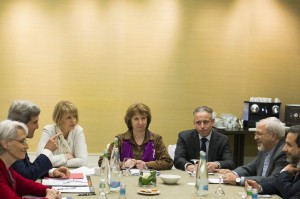 By the research staff of the Arms Control Association. To get this P5+1 and Iran Nuclear Talks Alert delivered to your inbox, sign-up now.
By the research staff of the Arms Control Association. To get this P5+1 and Iran Nuclear Talks Alert delivered to your inbox, sign-up now.
The P5+1 and Iran Nuclear Talks Alert will suspend its daily update until talks resume in August, but will update readers of the latest developments as necessary.
Off to the Races
 Ministerial-level negotiations during July 2014 meetings between the P5+1 and Iran on its nuclear program. (Reuters)
Ministerial-level negotiations during July 2014 meetings between the P5+1 and Iran on its nuclear program. (Reuters)
Talks between Iran and the P5+1 resume today with the first full plenary since negotiations were extended in July. Negotiators are meeting in New York City on the sidelines of the UN General Assembly and may remain through Sept. 27. While talks at the political-director level are on the books, it is likely that meetings will continue at the ministerial level next week, with Secretary of State John Kerry expected to join in and meet with Iranian Foreign Minister Mohammad Javad Zarif.
U.S. President Barack Obama, Iranian President Hassan Rouhani, and Prime Minister Benjamin Netanyahu are also expected to travel to New York to speak at the opening of the 69th UN General Assembly session next week. The three leaders are likely to address the status of the nuclear talks. Speculation abounds about a possible meeting between Obama and Rouhani after last year's historic phone call, but it seems unlikely at this point.
--KELSEY DAVENPORT, Director of Nonproliferation Policy
Clock is Ticking
With just over two months to the Nov. 24 deadline to reach a comprehensive nuclear agreement, negotiators have their work cut out for them. While negotiators made progress on key issues leading up to the decision to extend the talks, gaps remain.
One of the most significant gaps that remains is over the size and scope of Iran's uranium-enrichment program. Iran has said repeatedly that it wants to scale up its uranium-enrichment capacity to provide reactor fuel for its Bushehr nuclear power reactor in 2021 and other reactors it plans to build in the future. The P5+1, however, wants to limit Iran's current capacity (10,200 IR-1 centrifuges) in order to increase the amount of time it would take for Iran to dash to a nuclear weapon, if Tehran chose to do so.
In a Sept. 16 speech at Georgetown University, Undersecretary of State Wendy Sherman, and lead negotiator for the United States, said that she expects Iran to "try to convince the world" that the status quo or its equivalent should be acceptable on uranium enrichment, but it is not. The P5+1 has presented ideas to Iran that are "fair, flexible, and consistent with Iran's civilian nuclear needs and scientific knowhow," she said.
These goals, however, are not mutually exclusive. The right formula can meet the core concerns of both sides. The Arms Control Association and the International Crisis Group formulated a proposal to demonstrate that a solution is possible. A write up of the proposal is available online.
Negotiators also believe that the uranium-enrichment gap can be bridged and that a good deal is achievable by Nov. 24.
In a Nov. 17 interview with NPR, Prime Minister Mohammad Javad Zarif said that Iran is "ready for a good deal, and we believe a good deal is in hand." Iran is willing to "stay with the negotiations until the very last minute," he said.
Despite remaining gaps, progress has been made on a number of key nuclear issues. To recap, there is general agreement that
- the Arak heavy-water reactor will be modified to produce less weapons-useable plutonium;
- the Fordow facility will likely be transitioned from producing enriched uranium to a research and development facility; and
- increased monitoring and verification measures will be put in place, including the Additional Protocol, which grants increased access to the International Atomic Energy Agency for monitoring and verification.
Rewind 12 Months....
On the sidelines of last year's UN General Assembly, newly-elected President Hassan Rouhani's negotiating team met with the P5+1 for the first time. At that time, Iran's nuclear program was advancing and the international community was ramping up sanctions pressure. A decade of diplomacy had thus far failed to achieve concrete results.
But by November 24, 2013, just two months after the historic meeting, Iran and the P5+1 reached an interim agreement, known as the Joint Plan of Action.
Under the terms of the Joint Plan of Action, Iran's nuclear program has remained frozen. Iran has not installed any further centrifuges and halted construction on the Arak heavy-water reactor.
Key elements of proliferation concern were also rolled back under the agreement. Iran stopped producing uranium enriched to 20 percent and its stockpile of 20 percent enriched uranium was blended down or converted to powder form. Iran agreed to daily access to its uranium enrichment facilities and allowed the IAEA to visit facilities it had been denied access to for years. In exchange, Iran received sanctions relief.
In short, over the past year, both sides followed through on their commitments. Twelve months from now, hopefully, we can look back and see what progress has been made on a comprehensive deal.
Looking Ahead ...
September 15-19 - IAEA Board of Governors Meeting
September 18 - P5+1 - Iran talks resume at the political director level
Week of September 22 - Iran P5+1 Ministerial level meeting (likely)
September 22-26 - IAEA General Conference
November 24 - Target date for the conclusion of the comprehensive nuclear deal
